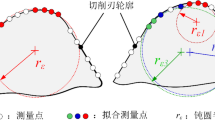Abstract
A two-dimensional finite element (FE) model of orthogonal cutting Fe-Cr-Ni stainless steel has been built with finite element software AdvantEdge to optimize the geometric parameters of cutting edge. The effect of these parameters on stress and temperature has been analyzed. The optimizing methodology of cutting edge geometric parameters has been proposed. Then, the geometric parameters of cutting edge have been optimized based on FE simulated results. It finds that, with the increase of rake angle (0°~10°) and cutting edge radius (40~80 μm), there is a minimum value of the tool stress. Given relief angle is 7°, the optimal rake angle for rough machining Fe-Cr-Ni stainless steel is 6°, and the optimal cutting edge radius is 60 μm. The cutting parameters have less influence on the optimized results in rough machining Fe-Cr-Ni stainless steel. Basically, for rough machining Fe-Cr-Ni stainless steel, the geometric parameters of cutting edge have little influence on the temperature, but influence the stress greatly. Keeping the equal material removal rate, larger cutting speed and smaller feed rate can obviously reduce the stress and the highest temperature in the tools.
Similar content being viewed by others
References
Chagas GMP et al (2013) Thermal analysis of the chip formation in austenitic stainless steel. Procedia CIRP 8:293–298
Zhao BZ, Shang HM, Xin JZ (2014) Design and application of modern tools [M]. National Defense Industry Press, China. (In Chinese)
Jiang F, Yan L, Rong Y (2013) Orthogonal cutting of hardened AISI D2 steel with TiAlN-coated inserts—simulations and experiments. Int J Adv Manuf Technol 64(9–12):1555–1563
Maurel-Pantel A et al (2012) 3D FEM simulations of shoulder milling operations on a 304L stainless steel. Simul Model Pract Theory 22:13–27
Ben Moussa N, Sidhom H, Braham C (2012) Numerical and experimental analysis of residual stress and plastic strain distributions in machined stainless steel. Int J Mech Sci 64(1):82–93
Arısoy YM, Özel T (2015) Prediction of machining induced microstructure in Ti–6Al–4V alloy using 3-D FE-based simulations: Effects of tool micro-geometry, coating and cutting conditions. J Mater Process Technol 220:1–26
Díaz-Álvarez J et al (2014) Numerical analysis of thermomechanical phenomena influencing tool wear in finishing turning of Inconel 718. Int J Mech Sci 82:161–169
Kheireddine AH et al (2013) An FEM analysis with experimental validation to study the hardness of in-process cryogenically cooled drilled holes in Mg AZ31b. Procedia CIRP 8:588–593
Wu HB, Zhang SJ (2014) 3D FEM simulation of milling process for titanium alloy Ti6Al4V. Int J Adv Manuf Technol 71(5–8):1319–1326
Ambati R, Yuan H (2011) FEM mesh-dependence in cutting process simulations. Int J Adv Manuf Technol 53(1–4):313–323
Jiang F et al (2010) Al7050-T7451 turning simulation based on the modified power-law material model. Int J Adv Manuf Technol 48(9–12):871–880
Ma J, Duong NH, Lei S (2014) Numerical investigation of the performance of microbump textured cutting tool in dry machining of AISI 1045 steel. J Manuf Process. doi:10.1016/j.jmapro.2014.10.001
Ning F, Ming C, Pequan G (2009) Simulation of Cutting Tool Geometry Parameters Impact on Residual Stress. 2009 Chinese Control and Decision Conference. CCDC 2009. p. 5472–5475
Jing X et al (2009) Investigations of tool geometry in ultraprecision cutting: A FEM simulation approach. IEEE. p. 5099–5104.
Bil H, Kılıç SE, Tekkaya AE (2004) A comparison of orthogonal cutting data from experiments with three different finite element models. Int J Mach Tools Manuf 44(9):933–944
Lin YC, Chen XM (2011) A critical review of experimental results and constitutive descriptions for metals and alloys in hot working. Mater Des 32:1733–1759
Yu J et al (2014) Numerical study the flow stress in the machining process. Int J Adv Manuf Technol 74(1–4):509–517
Altintas Y (2012) Manufacturing automation: metal cutting mechanics, machine tool vibrations, and CNC design. American Library Association CHOICE. p. 116
Chen RZ (2012) Metal cutting theory [M]. China Machine Press, China. (In Chinese)
GB/T2076-2007 (2007) The Carbide Indexable Inserts Design Standards [S]. China National Standardization Management Committee
Author information
Authors and Affiliations
Corresponding author
Rights and permissions
About this article
Cite this article
Cheng, X., Zha, X. & Jiang, F. Optimizing the geometric parameters of cutting edge for rough machining Fe-Cr-Ni stainless steel. Int J Adv Manuf Technol 85, 683–693 (2016). https://doi.org/10.1007/s00170-015-7892-6
Received:
Accepted:
Published:
Issue Date:
DOI: https://doi.org/10.1007/s00170-015-7892-6



